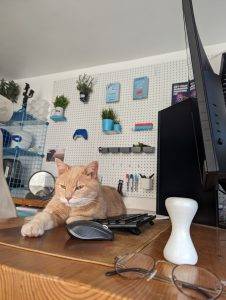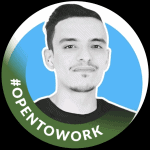I distinctly remember the first time I felt like a “solopreneur” instead of a freelancer.
It was a powerful feeling.
In fact I snapped a pic to celebrate the moment.
Pardon my pasty white Scottish manboobs.

It was a Friday.
It was sunny (a rare thing in Scotland), so I’d rushed out to a nearby Loch to float about in the kayak.
I was just drifting off to the gentle lapping motion of the boat when my phone buzzed….
Despite myself, I checked the alert.
It was an email with an urgent request from a client with an issue on a website.
These didn’t come up that often, were usually minor and quick fixes.
But due to the number of clients I’d built up over the years, I found just maintaining all the existing clients had started to suck up most of my days and each one was always relatively urgent, to the point where each time my phone buzzed I started to feel a pit in my stomach wondering how I would fit it in beside new client work.
Luckily, I had just made my first hire (a flexible retainer role for WordPress support) and it was his first test.
So I forwarded the email to him, and started to paddle my way back.
But by the time I was halfway back, he’d already logged in, sorted it, and marked the task as complete, which in turn sent an automated email to the client to let them know it had been handled.
Just because you’re a solopreneur doesn’t mean you have to work solo.
My interpretation of “solopreneuring” is less descriptive.
I see it as a business model which encompasses the philosophy of doing more with less:
lean, systemized, automated.
Whilst entrepreneurs scale fast, hire quickly, and chase revenue,
Solopreneurs avoid risk, put profit first, reduce first, and hire only when it’s right.
I follow the solopreneurs mantra:
- Always eliminate before you systemize
- (why build a system for something you don’t need?)
- Always optimize before you systemize
- (repeating bad process only amplifies bad outputs)
- Always systemize before you automate
- (You can’t automate it, if it isn’t repeatable)
- Always automate before you hire someone to do it.
- (it costs less and takes less time and management)
But even this will only get you so far…
By this point if you’re anything like me you may have been working like a dog for years, trying to take on everything yourself.
If you want to break past the typical ceiling that most freelancers hit, then you’re going to need help.
What gets you past your first 50k, won’t get you past your first 100k.
Building a small team to grow your business could be one of the most important milestones in your business, especially when it comes to clawing back your freedom.
I must admit, when I finally caved and paid someone to help me if felt like failure.
But then I quickly discovered the power of delegation.
Having a small team means you don’t have to shoulder all the mental load in your business.
It means other people to bounce ideas off of,
and other opinions and ideas to enhance your own.
In one year my team has grown from 1 (just me) to 5.
We work fully remote across the globe, almost entirely asynchronously. We have one short catchup a week.
But it took me a lot of trial and error, frustration, and patience to get to this point.
I kissed a lot of frogs before I found my prince and princesses.
I spent long days writing SOPs, training, biting my tongue, and tearing my hair out until reality caught up with my expectations.
I made some bad hires of people who really took advantage.
I made some bad hires of people who tried but just weren’t a good fit.
You can spend months investing time and training people and only to find it’s no-one’s fault, they just aren’t a good fit.
Hiring the right people is a major challenge. Especially when you’re doing complex knowledge work.
My approach to hiring and working a team is pretty simple:
Don’t do all the annoying shit your bosses did that made want to quit the 9-5 in the first place.
Here’s some training I wrote about hiring a while ago for one of my students:
You may find it useful.
I used this model to hire VAs, designers, copywriters for both full-time, retainers and one off projects.
Here’s how I’ve handled it.
My alternative guide to hiring a team
So you’ve reached the magic stage where you start to get “off the tools”
and outsource some of your roles to someone so you can spend your own valuable time on the highest-value tasks.
Congrats you’ve taken the next step in building a lifestyle business.
But how to find the right people?
Finding good people is one of the most challenging things.
Hiring Process
Phase 1 – Search for Talent
Go to job boards and search by job description.
Upwork.com is pretty good you can find “VAs” admin roles, marketing assistants, appointment setters, remote sales folk etc.
If it’s design, go by portfolio.
ask yourself “could I pitch this to a client with a little polishing?”.
If it’s an admin role or marketing role it’s very hard to judge until they do the job.
That’s why it’s important we test them first before committing to a full-time role or even waste a month on a probation period.
If their portfolio of their very best work is crap it’ll take a lot of work to get much better.
You’re looking for someone who has the basic foundations and is open to growth & coaching from there.
You can search by job role, and look at their profiles.
- Do they have a good profile picture,
- Is their profile well-written
- Do they have testimonials
- And examples?
Pin any good ones.
Send a very brief message asking if open to work, so we don’t waste time on those who aren’t active.
At this stage look for comms.
- Do they respond well?
- Do they specifically reference something you’ve said, instead of a template reply?
- I would bin any templated replies.
Then send longer intro to any who respond favourably, or invite to a job brief.
Phase 2 – Post a Job
Post a job posting, outlining the job.
I like to be super detailed.
Have you ever spent hours applying for a job where the job description doesn’t match the role?
Or the hours weren’t clear?
Or the compensation wasn’t obvious?
No explanation of the day-to-day?
Seriously, what the fuck does “competitive” mean anyway? competitive with who?
Any relationship has to be a win-win.
I don’t believe it’s fair to ask people to spend time on an application if they don’t know what they are applying for.
So I’m super detailed in my application.
I also highlight the job perks, which includes remote working, coaching, training, and nurturing.
This is important as you’ll attract more self-starters, who see the value of long-term learning on the job.
Some people will say “It’s not my job to learn, I’m there to do a job and that’s it”.
That’s fine if you want to work the same job for the next 20 years.
But things move so fast that in 5 years your job won’t even exist anymore.
So don’t expect to get ahead if you don’t raise your game.
I’m looking for people who want to learn, who like to learn, and who value learning.
I look for anyone who has built their own portfolio website, made a PDF portfolio, or have some kind of personal brand on social.
It’s usually a sign they are a self-starter.
Here’s what I use, I shorten and customize it depending on the job role I’m looking for.
Some people like to write much shorter applications,
but I’ve found being more detailed is fairer to the candidate,
gives them all the info they need,
and gives them more of an opportunity to respond with specific details,
Instead of a canned template response.
It also makes the cookie-cutter or template responses really obvious so you can discard the lazy applications.
”
Hi there, Nick here from Design Hero!
I’m looking for someone to work long-term for me as a web designer to design and build amazing websites for Design Hero.
— Job Description
— About the role
This is a permanent, part-time, or full-time role.
between X – Y hours per week, depending on your availability.
Training and mentoring will be provided for any skills that you don’t have, or would like to learn.
Salary is X – Y, * Be transparent here*
depends on your experience, and hours *Insert any variables here*
— What I need from you.
Design Hero is looking for someone to join our team long-term.
Your skills and experience are less important than your mindset, enthusiasm, and ability to learn.
We’re looking for someone who is comfortable taking on new things, likes running their own projects, and is eager to learn new skills.
We’re looking for someone who knows how to follow instructions and reliable, but capable of thinking outside the box and bringing their own suggestions and ideas to the table.
— What I’ll provide for you.
I’m highly flexible on working times and environment, so long as the job gets done.
I’m always there to provide feedback, provide a helping hand, or do teaching.
I vet my clients just as carefully as I do my freelancers.
I make sure my team have enough time, resources, and training to achieve a good outcome.
I provide extensive training and mentoring for everyone on my team to take your skills to the next
You can learn more about Design Hero here
https://www.design-hero.com/
— List of Essential requirements
For this role, you must be confident in ALL the below…
• MUST be totally fluent in English reading, writing, speaking and listening.
• MUST have a minimum of 2 hours per day within 9am-5pm UK time (doesn’t need to be every day, but at least 2 days per week.)
• any software or skills you need
— List of Additional requirements which aren’t necessary, but would be useful.
• Knowledge of CSS isn’t strictly essential, but would be useful!
— Here’s what you’ll be doing day to day
• Reading and interpreting client briefs
• Looking for website inspiration
• Sourcing high-quality photography
• Designing website mockups in Figma / Adobe
• Creating highly optimized websites in Elementor and WordPress
• Managing and updating existing websites
• Investigating ways to achieve different functionality on websites.
• Responding to comments and updates on “Clickup”
• Learning and training new skills with me and the team
• Communication will mostly be through Clickup comments, sometimes we do recorded video screenshares too.
— How our application process works
I will review your responses to the vetting Questions below,
Then I will select a few people for a chat.
Don’t worry, this isn’t a formal interview, it’s a super casual chat 😊
Then the chosen candidate will be invited to do a one-off paid test job first to see if we are a good fit.
If we are a good fit, then we will agree on your salary for the permanent role.
— Vetting Q’s
Please answer ALL of the questions below.
• How do you get ideas for each website, are there any particular sites you use for inspiration?
• What is your process from start to finish?
• Please show me at least x3 websites you have designed fully yourself on Elementor. Try to show a range of different website types, blog, e-commerce etc.
• Do you have your own computer and internet access? if so how fast is your internet connection?
• What is the minimum and maximum no of hours you could work for this role? (Your hours and salary will be the same every month, I just need to know what your requirements are)
• Do you have any Qs for me?
Phase 3 – Zoom Interview
Keep it super casual.
This is basically to confirm
- they are who they say, and that they are in the country they say they are in,
- And that they can speak the languages they say they can speak.
- that they aren’t an agency masquerading as an individual,
- that they aren’t using chat GPT for the vetting questions,
- and also that they have stable internet.
Note it’s important at this stage not to let rappor influence your decision.
I’ve mistakenly hired the nicest people I got on with before, and they’ve been shite.
I’ve hired people who I noted that we had no rapport, or didn’t “hit it off” who were brilliant.
If they aren’t a good fit, they aren’t a good fit.
Focus on skills, and presentation, not niceness or outgoingness.
I usually just ask some casual icebreaker questions, plus a few general or industry-specific questions.
- Some sample Questions you can use.
- Please tell me a bit about yourself?
- How do you get ideas for each website, are there any particular sites you use for inspiration?
- What is your process?
- What made you decide to pursue this type of work?
- If you could work on one specialty what would it be and why?
- Have you worked with people in multiple time zones before?
- Are there any other skills you’d like to learn?
- Do you have any Qs for me?
Phase 4 – Run a low-risk test
This stage is essential.
It’s a low-risk paid project with a fixed start and end,
that if they screw it up it doesn’t matter, you can do it yourself quickly, or get one of your team to pick it up.
Make sure you set a fake deadline weeks ahead of the real deadline.
What we are looking for:
- How were the results? design is subjective, but you can still rate the skill for the foundations.
- Did they start promptly, or wait till the last minute to start it?
- Did they deliver ahead of schedule,
- Did they follow instructions?
- How were comms?
- How much handholding was needed?
- Did they take proactive steps, or wait to be told?
It’s hard to find all of the above.
Usually, you’ll find people are somewhere on a spectrum.
Some folk have great design skills but slow on comms.
That’s why you need a broad bench of different people for different situations.
Phase 5 – retainer or job offer
After a certain number of test cases with increasing complexity, risk, and investment,
I like to offer a retainer, for a fixed agreement which is a win-win for both freelancer and me, or a full-time role.
A full-time role will always secure more commitment and energy than one-off jobs.
It means taking on the burden of an ongoing overhead.
Just remember, as a solopreneur and a lifestyle business, profit comes first, and once you make that commitment your overheads will never go down.
But it gives you more security that your coaching and investment in them is going to stick around and reduces churn,
and in the long run, I’m convinced it’s cheaper to have a slow month and pay someone to sit around (or learn),
than it is to try start fresh with someone new each time.
Some other points for happy hiring
Here’s just a few things I’ve learned as someone totally new to hiring.
Don’t hire people you like.
I made the mistake of hiring someone who I liked, instead of someone who was the best fit.
I’ve hired quite a few people who were eager beavers to start with, and after the first month, performance, attitude, and comms quickly took a nose-dive.
It doesn’t matter if you like them, make sure they are qualified and get results.
Sometimes I’ve had people who are quiet in the interview and don’t ask any questions and I’ve thought “hmm they don’t get it”,
then they go away and quietly smash it.
Look for soft skills
Soft skills are the hardest to teach. Anyone can learn a software. It takes much longer to learn soft skills like comms, client handling, or abstract ideas like branding.
If you’re hiring for a design job look at portfolio as proof of ability first.
If you’re hiring for admin roles, look for attitude and ability to learn.
Your first hire should always be something you know how to do.
If you don’t know how to do it, how do you know they are doing it right?
Mindset matters more than skills
Mindset and ability to learn is far more important than specific skills or knowledge of specific tools.
- When you find someone and you work on your test project, keep an eye out for these things:
- How many times do you need to tell them something?
- Do they ask good questions?
- Do they take the next obvious logical steps, without you needing to tell them?
- Do things just happen by themselves? do they bring you the solutions? if so this person is a keeper.
Trust, but verify
I don’t want to be the kind of person who tracks every hour and output.
Doing this kind of micromanaging defeats the purpose of delegating in the first place.
If I’m going to get someone to do something, I want it off my plate, and off my brain.
So trust them to get results, but check in regularly.
Give them responsibility, but hold them accountable if they miss deadlines.
Make sure they know WHY things are important and the impact of things.
“It’s important we hit deadlines, because if we don’t the client wont trust us. if the client doesn’t trust us, they will question our work. which makes more work.”
Make sure they know mistakes are allowed
This is important.
Make sure everyone knows mistakes are ok.
Everyone makes mistakes. All that matters is the result. identifying and fixing mistakes is just part of the process and part of how we improve the process.
If your team feel there’s no silly questions and they can ask you about mistakes then you’ll have less fires to fight.
Hiding mistakes festers into larger problems.
If you don’t stress this, and encourage the idea of continuous peer learning, you’re going to get a nasty culture “pass the buck” culture and cover-ups.
I think everyone has worked in at least one place with a culture like this. It’s not nice.
speaking of failure…
When they fail at something
Not if. When.
Most often it’s your fault.
A lot of bad bosses are lazy and don’t write a good brief or explain what they want.
People aren’t mind readers.
Lazy inputs = lazy outputs.
- set deadlines ahead of the actual deadline.
- make sure they have everything they need
- check the brief describes everything you expect, what to do, how to do it , what not to do, examples.
- Make sure they understand the larger context, not just a small bit of whatever task you’ve asked them to do.
Continuous Feedback
The faster you iterate, the faster they learn.
Make sure you feedback on everything they do, good or bad.
But gently.
To help them learn not to make them feel bad.
And encourage them.
So many employers only criticize, and fail to highlight what they’ve done right.
Don’t hire full-time straight away
The traditional route is offer someone a full-time role with a probation period.
It’s very difficult or awkward to say to someone they aren’t a good fit.
They usually have to be pretty bad for you to take the route of canning them before probation.
This is how many small business owners end up with a team that’s ok, or possibly even acceptable, saddled with the burden of overheads, but not quite bad enough to take the drastic measure of firing them.
Taking a phased approach means finding the right people for the right role,
And providing them with a win-win job that they can enjoy and grow in.
Expand your talent pool
Harsh truth:
A lot of people applying for jobs aren’t actually any good at their jobs.
How long you’ve been doing it, has no relation to skill or ability.
I found this strange. Surely experience = quality
But then I read recently that 60% of people report they think they are in the wrong job.
this is because they take the roles that are offered to them from a limited plate.
Everyone is thinking local when we live in a remote and virtual age.
Expand your hiring pool to a worldwide net, and you’ll quickly find there’s a world of talented people who are an ideal fit.
Alternative Skills
Although your first hires should be things you know how to do, It’s also important to find people who can do things that you can’t, or don’t want to.
I’m not good with social media. I can do it. but I hate it. So I found someone who’s more passionate about it.
Remote working
Hiring creative talent to work remotely is challenging.
It requires trust.
In my experience, when I worked a 9-5 bosses were always worried about remote workers not doing their jobs when they weren’t being watched.
But bums on seats doesn’t equal productivity or creativity.
In the office, anyone can hide behind a desk pretending to work.
With remote work, the difference between coasters and the grafters is immediately obvious.
let me present an alternative theory:
grafters graft, whether they are at home or in the office.
coasters coast, whether they are at home or in the office.
To me nothing matters but output.
I don’t care if they only work 1 hour a day, so long as they get the results.
Focussed, productive people will often get more done in a fraction of the time, than people who pretend to work all day.
The differences are just more obvious with remote work.
The right person isn’t enough. everyone will need nurturing.
I treat everyone on my team, even one-off freelancers as if they were a core member of my team.
I coach and nurture their skills for free and give advice freely.
It takes x5-10 times as much time to do this than just to do it yourself.
but the goal is to find someone who wants to grow and who can be an ongoing part of your team.
and it’s rewarding as it helps a freelancer grow..
If you invest the time now it’ll save future you even more time later.
Hope that helps!
Happy hiring























